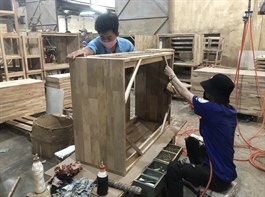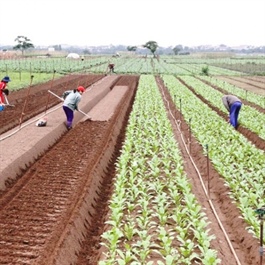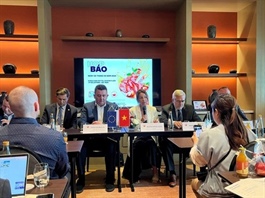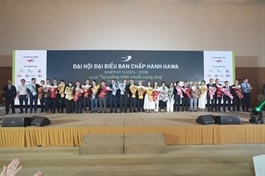Support initiatives fuel growth in craft villages
Support initiatives fuel growth in craft villages
A series of trade fairs and exhibitions in Hanoi and throughout the country serve as a great support for businesses and handicraft villages.
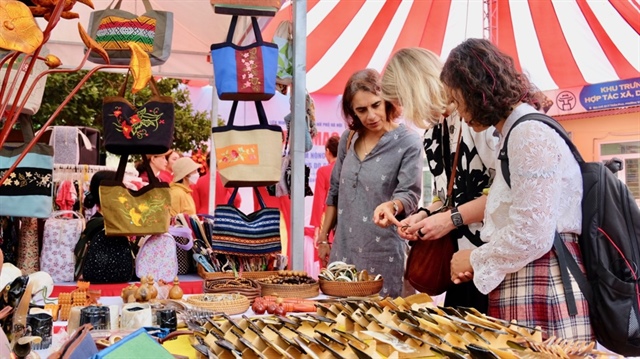
Many foreigners are interested in Hanoi's handicrafts. Photo: Trong Tung/ The Hanoi Times |
Promotional activities include "Promotion of Agricultural Products, Traditional Handicrafts and Outstanding OCOP City Products", which took place from August 9-11 in the northern province of Dien Bien.
Another program on "Product Promotion and Tourism Link between Hanoi and Ho Chi Minh City" is scheduled for August 23-25 in Ho Chi Minh City.
In addition, a festival showcasing the skills of artisans and craftsmen and an exhibition of Hanoi handicrafts will be staged at the Hoan Kiem Lake Walking Area from September 12 to 15.
The traditional crafts including lacquerware, needlework, porcelain, silk, bamboo, and new items will be showcased at the events.
Nguyen Anh Duong, Director of the Hanoi Promotion Agency, said that the center has held a large number of trade fairs and exhibitions in the city and throughout the country, which is a great support for businesses and handicraft villages.
Embracing technology for craft product promotion
To enhance product promotion, craft villages have promoted trade by using social media, e-commerce platforms, digitizing data and creating dedicated websites.
Villagers have developed sales strategies on social media platforms such as Facebook, Zalo, and YouTube, and have learned skills in videography, photography, and writing engaging product descriptions.
Doing business online has allowed these villages to stay connected with existing customers and reach potential new ones.
Pham Khac Ha, chairman of the Van Phuc Silk Weaving Association, noted that businesses in Van Phuc have organized group-based online sales models. Through these groups, members actively source production materials and showcase their handmade products.
With the data collected, businesses can advertise and network with interested buyers in a more targeted manner. Many local businesses have also embraced technology for online consultations and sales, and are gradually moving to cashless payments.
At present, Van Phuc has 400 households involved in silk production and 244 enterprises operating in the handicraft industry cluster. In addition to silk weaving, there are 150 family-run shops selling silk-related products. The annual silk volume reaches 1.7 million meters, generating an estimated revenue of VND115 billion (US$4.5 million).
In Gia Lam District, many workshops in the Bat Trang Pottery Village are also working to provide information to tourists through QR codes, allowing visitors to easily use their smartphones to find details about local showrooms and OCOP [One Commune One Product] products.
Dang Dinh Tuc, a representative of Giang Cao Pottery Village, reported that the village is home to 195 enterprises, 960 production households, and 750 service providers in pottery and tourism, with an average income per person of more than VND86 million ($3,424) per year.
According to him, customers around the world have become more aware of these traditional artisan villages, as villagers have quickly realized the benefits of product digitization.
To support these villages in their digital transformation, the Hanoi Department of Planning and Investment has launched initiatives, including programs for innovative startups and support for small and medium-sized enterprises (SMEs) from 2019 to 2025, with a focus on digital transformation during this period.
The city also provides assistance with digital signatures and e-invoicing for new businesses, as well as training.
Revenue growth
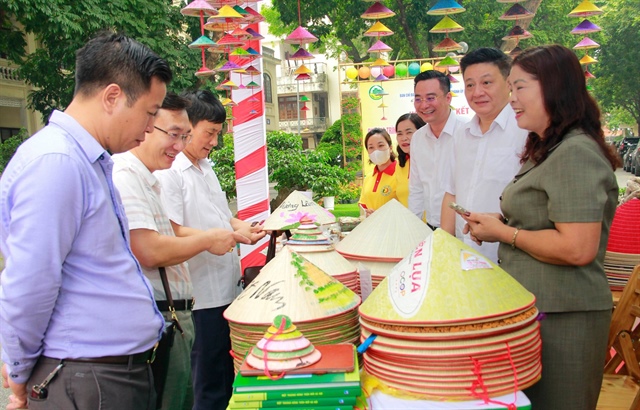
The conical hats of Chuong Village are among Hanoi's famous traditional handicrafts. Photo: VGP |
In recent years, craft villages have seen significant growth in revenue, production value, and export value. More villages are achieving impressive annual revenues, such as the Son Dong Artisan Village with VND2.85 trillion ($113.5 million), the Duong Lieu Agricultural Processing Village at VND1.6 trillion ($63.7 million), and the Phung Xa Agricultural Machinery Village with VND1.2 trillion ($47.8 million).
Rural artisans earn significantly more than farmers, with average monthly incomes ranging from VND4 million to VND5.5 million ($159-$219). In several districts, artisans report average annual incomes of more than VND50 million ($1,991), including districts such as Nam Tu Liem, Tay Ho, Ha Dong, Hoai Duc and Thach That.
Nguyen Van Chi, Director of the Hanoi Agricultural Extension Sub-Department, said: "Craft villages not only excel in their crafts and products, but also serve as important economic resources for localities. Reports from 24 districts show that the total revenue from craft villages and traditional handicrafts exceeds VND24 trillion ($955.8 million) annually."
The results are attributed to the city's suporting policies for craft villages.
Nguyen Thi Luong, representative of Hien Luong Bamboo and Rattan Export Co., Ltd (Phu Tuc Commune, Phu Xuyen District), said her company exports handicrafts to Europe and America, and has received substantial support from Hanoi and the district in vocational training. In particular, their export products benefit from 100% tax reduction and streamlined customs procedures.
Support policies

Hanoi craftspeople make rattan and bamboo products. Photo: The Hanoi Times |
The year 2024 marks a pivotal point for Hanoi as it strives to achieve its rural economic development goals outlined in Program No. 04-CTr/TU, which emphasizes three key resources, including cooperatives, agrarian economies, and craft villages.
Nguyen Manh Quyen, Vice Chairman of the Hanoi People's Committee, believed that Hanoi, with its rich tradition of artisan villages, has the potential to further accelerate rural economic development.
He pointed out that in order to promote the growth of handicraft villages, many districts have recently set up industrial zones. Since the beginning of 2024, the city has started infrastructure investment in four industrial clusters, including Dong Phu Yen in Chuong My District, Tam Hiep and Lien Hiep (Phase 2) communes in Phuc Tho District, and Xa Cau commune in Ung Hoa District.
Quyen said the city is working to have a comprehensive plan for the development of handicraft villages by September 30. It will effectively utilize the resources of craft villages, boosting rural economic growth and improving the livelihoods of local residents.
Tran Sy Thanh, Chairman of the Hanoi People's Committee, also affirmed that the city will soon introduce more flexible policies to help businesses, cooperatives, and small producers in artisanal villages gain easier access to land, financing, technology, and markets.
In addition, city leaders will direct various departments to translate these initiatives into concrete programs and plans to ensure that the amended Capital Law is effectively applied to foster the development of artisan villages.




